|
Jim Cowels' - Boston
Trawler Mountfleet Kit |
|
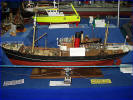
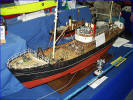
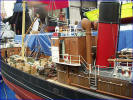 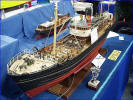 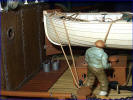
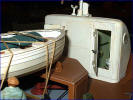
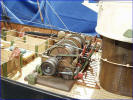
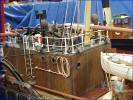 |
Beer & Boats
I'm Jim and I am a member (erstwhile treasurer and Vice Chairman) of
Anglia Marine Model Club, based in Northampton, a bunch of nutters - well
not everybody, I think there was this one chapů.
|
|
I'm a stickler for detail myself, and this is my downfall. Can't seem to
accept anything if it ain't just so and I do tend to go to the most
extraordinary lengths in search of realism. Take my Boston Typhoon, it
started out as a diversion to keep me out of the pub. No chance! -
frustration and complications set in from the start and for the 4 and a
half years it took to complete, I've not had a day out of the pub because
of it!
Lead ballast. It needed plenty, 'cos I calculated the displacement at 45
pounds. Best to keep this low in the hull, right? Slapped a load of lead
sheet in the base of the hull and resin-ed it all in under a nice flat ply
base. Trouble is with lead, it doesn't look as if it weighs as much as it
does, until you try and lift it - 25 pounds and that's just the bare hull,
but the resin has set! Time for another pint.
Spraying. I just love it, especially when the white acrylic spray can
nozzle disintegrated. Paint everywhere, all over me fleece and face and
glasses. Took it back to the shop looking like I'd been caught in a
blizzard. Laughter all round, except me. Adjourned back to the local.
Printed kit decks. I hate them, so proceeded to cut individual planks -
hundreds of the little devils. Great idea, but it took so long I was
beginning to despair, 'til a mate came round and suggested we go for a
drink. Sanity was restored.
Then there was the 24 hour model boat marathon. Two in the morning and I
was parched. Wandered around and found a can of beer somewhere. Started
back to resume my steering duties only to trip a over in the pitch
darkness and hit my head, blood all over the place. Still holding the can,
I am branded a drunk but I hadn't touched a drop, so I down the beer
anyway, had another and then crashed the ship into the far bank. Time for
another beer, but where can I get another one at this hour?!
Superglue
has changed modelling so much. What a fantastic invention. We were just
about to go out to a restaurant one night, but thought I'd glue a couple
of bits onto the half built Boston Trawler before I left. A doorbell rings
informs me that the taxi has arrived, I turn to go, but me best shirt,
which is by this time glued to the bench, does not go with me. OK, it's
only a shirt, but then I realise I've got all this missing skin.. Luckily
I managed to replenish the loss of blood by an urgent transfusion from the
restaurant bar. |
|
What about keeping 'er indoors happy? Not a chance I hear you say, and so
is the way of life, but where modelling is concerned it's even more of a
problem. I accidentally sprayed part of the kitchen once with Halfords red
primer (I thought it looked quite good - lovely finish). Once a meal had a
distinct taste of white spirit. There's just no arguing in these
situations and I have found it best to adjourn to the local.
I actually got the missus interested in model boats. Built her a nice
little Customs launch and sunk it on it's first outing in our clubs six
foot deep lake! OK, I'd had a couple of pints, but it wasn't my fault, I
didn't see the 9 foot long battleship bearing down on me - it's the
camouflage!. Anyway, it was me birthday and so I took refuge and solace in
the beer tent.
To finish off the Boston Trawler I got permission to put it on the dining
room table for a few days. I went out for a quick spin on the motorbike.
Wrote it off, nearly wrote myself off, but with all my broken parts, the
boat stayed on the table for five months. That went down really well, but
I did manage to complete it by doing all the rigging with a broken
shoulder (now that's dedication) - but only due to all the special
medicine I was able to get down - luckily my drinking arm was undamaged!
|
|
For the technical stuff:
BOSTON TYPHOON FD 272
A 1948 Fleetwood Trawler
This model is based on a Mount Fleet Models kit, with GRP hull,
superstructure mouldings and ships boat, wood sheet, strip and dowel,
brass and steel rod and over 1300 cast metal fittings. It is 55" x 11"
(1400 x 280mm) and displacement to waterline is 45 pounds (20.5 kg).
It is fitted with a 12 volt Pittman electric motor and two function radio
control for rudder and electronic speed controller. Three separate
lighting circuits feed grain of wheat bulbs (25 in total) for Navigation
Lights, Interior Lighting and External/Deck Lights.
Building spanned four and a half years up to July 2003 and total time on
the project is estimated at well over 1200 hours. I just lost count.
The kit has been enhanced by a number of modifications, additional detail
and internal fitting out. The fidelity to the original has been maintained
and improved where possible, by reference to a number of publications,
shipbuilders plans of similar vessels, historic photographs, web sites and
internet discussion forums. A full set of trawl gear and exact scale nets
is also included.
Paint is generally airbrushed Humbrol enamel and various types of acrylic.
Undercoats are from Halfords acrylic spray cans, as is the hull below
waterline. The entire ship is finished with Ronseal Matt Polyurethane
Varnish, thinned 50/50 with white spirit and airbrushed, the number of
coats varies between 1 and 4 depending on location.
|
|
The kit has been modified
as follows:
1. Decks.
All printed plywood deck sheets are replaced with individual planks to
scale size and stagger, with caulking represented by indelible ink. Plank
ends are correctly joggled into margin planks, with trim planks around
major deck fittings.
The method of construction was to glue individual planks, 1/32" (0.8mm)
thick onto 1/64" (0.4mm) plywood deck sheets which were cut to size from
card templates drawn from the 1/16" (1.5mm) sub-decks. Individual planks
were cut from varnished sheet wood and clamped together before sanding to
uniform width. The pre-varnishing preventing the spirit based caulking ink
from running into the surface grain.
The three completed deck sheets (fo'c's'le, welldeck and main deck) were
then epoxy glued to the sub deck after the painting of it's margins.
Approximately 400 individual planks were used.
2 Wheelhouse.
I required the wheelhouse interior to be fully fitted out and lit. For
this reason, the GRP moulding supplied with the kit was discarded in
favour of a plastic card fabrication. Two were produced before I was
satisfied with the result. This allowed scale thickness of the
construction, greater accuracy and consistency in the representation of
the prominent window array and also gave a smooth, flat interior surface.
External rivet detail was reproduced by pressing a centre punch into the
plastic plates that make up the structure.
Interior fitments, beyond those supplied, include duck boards, scale tea
mugs and shelf, charts and correct scale dial faces to the ships
telegraphs (photo-reduced from internet images).
3 Engine Room.
Within the engine room and visible through it's skylights (made with
opened and stayed vents for this purpose) is a model of a Triple Expansion
Steam Engine, typical of the type used in trawlers of the period and
constructed to true scale.
This has all cylinder head bolt detail, inlet and exhaust pipework, steam
valves etc. as well as high level access walkways with open mesh flooring
and handrails. Two lamps provide illumination.
4 Galley.
Inside the rear casing door is a fully fitted out Galley kitchen, the
layout of which is taken from ships plans of a similar vessel. The range
is fitted with pan restrainers, necessary in rough waters, and a variety
of pots and pans, cooking utensils, and a clock with roman dial (again
from an internet image).
The checkered tile floor (scale 4" ceramic tiles) is varnished printed
card produced using a simple imaging program (MS Paint). Further lamps
illuminate the galley.
5 Cod Liver Oil House.
This is the structure at the stern. Supplied as a GRP moulding, I have
fitted it out with a Cod Liver boiler and its' steam pipes and a large
container of cod livers ready for boiling.
The toilet with lid in the raised position indicates a male crew!. Note
the toilet roll. Further detail has been excluded in the interests of good
taste!
6 Fo'c'stle
Through the door can be seen the lobby leading to the forward living
quarters and store rooms. Note the mop and bucket.
7 Trawl Nets
The trawl nets laid out on the starboard deck will open out to a scale
replica of a full size trawl complete with floats, bobbins and all the
brackets, equipment and warps required to shoot the nets.
|
|
|